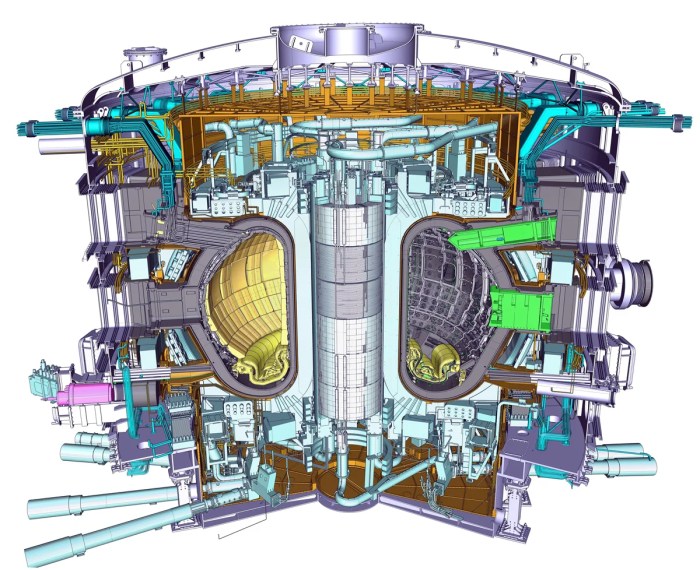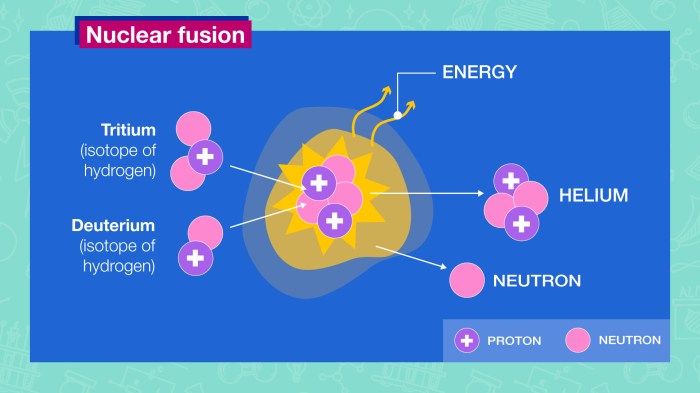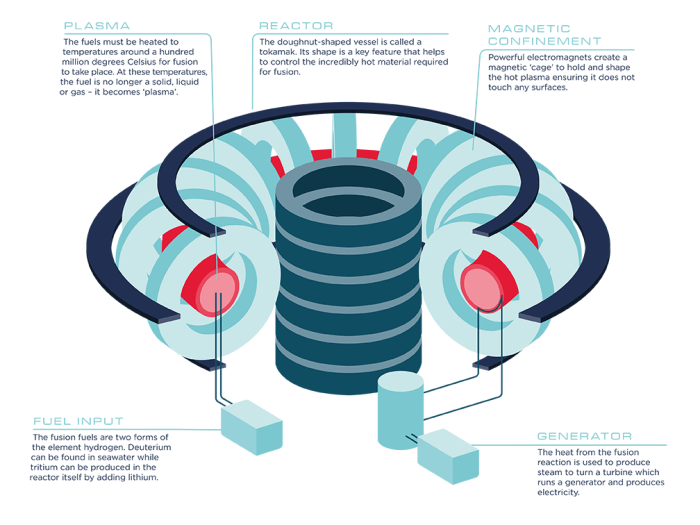Fusion reactor mekanism represents a transformative technology with the potential to revolutionize the energy landscape. By harnessing the power of nuclear fusion, these reactors offer a clean, safe, and virtually limitless source of energy, promising to meet the world’s growing demand for sustainable power.
Delving into the intricacies of fusion reactor mekanism, this comprehensive guide explores the fundamental principles, types, fuel sources, safety considerations, and ongoing research and developments in this captivating field.
Fusion Reactor Mechanism

Nuclear fusion is a process that combines two atomic nuclei into one, releasing a large amount of energy. This process is the opposite of nuclear fission, which splits an atomic nucleus into two or more smaller nuclei. Fusion reactions are the source of energy for the sun and other stars.The fundamental principle behind fusion reactions is that the mass of the two nuclei that are combined is greater than the mass of the single nucleus that is produced.
This difference in mass is converted into energy according to Einstein’s equation E=mc^2.There are two main types of fusion reactors: magnetic confinement fusion (MCF) and inertial confinement fusion (ICF). MCF reactors use magnetic fields to confine the plasma, which is a hot, ionized gas that contains the nuclei that will undergo fusion.
ICF reactors use lasers or particle beams to heat and compress a small pellet of fuel, which causes the nuclei to fuse.Fusion technology is still in its early stages of development, but it has the potential to provide a clean and safe source of energy.
However, there are a number of challenges that need to be overcome before fusion reactors can become a commercial reality. These challenges include:
- The high temperatures and pressures that are required for fusion reactions
- The need to confine the plasma for a long enough period of time
- The development of materials that can withstand the harsh conditions inside a fusion reactor
Despite these challenges, fusion research is making progress, and there is hope that fusion reactors will one day become a reality.
Types of Fusion Reactors

Fusion reactors are designed to harness the energy released by nuclear fusion reactions. There are several different designs for fusion reactors, each with its own advantages and disadvantages.
Tokamaks
Tokamaks are the most common type of fusion reactor. They use a powerful magnetic field to confine a plasma of charged particles within a doughnut-shaped vacuum chamber. The plasma is heated to extremely high temperatures, causing the nuclei of atoms to fuse and release energy.
- Advantages: Tokamaks have a relatively simple design and are relatively easy to operate.
- Disadvantages: Tokamaks require large amounts of energy to create and maintain the magnetic field.
Stellarators
Stellarators are similar to tokamaks, but they use a more complex magnetic field configuration to confine the plasma. This allows stellarators to operate at lower temperatures than tokamaks, which reduces the amount of energy required to create and maintain the magnetic field.
- Advantages: Stellarators can operate at lower temperatures than tokamaks, which reduces the amount of energy required to create and maintain the magnetic field.
- Disadvantages: Stellarators are more complex to design and build than tokamaks.
Inertial Confinement Fusion
Inertial confinement fusion (ICF) uses a powerful laser or particle beam to heat and compress a small pellet of fuel. This causes the nuclei of atoms in the pellet to fuse and release energy.
- Advantages: ICF can achieve very high temperatures, which increases the efficiency of the fusion reaction.
- Disadvantages: ICF is a very complex and expensive technology.
Key Components and Systems of a Fusion Reactor
All fusion reactors have several key components and systems in common. These include:
- Vacuum chamber: The vacuum chamber is where the fusion reaction takes place. It is made of a material that can withstand the high temperatures and radiation levels inside the chamber.
- Magnetic field coils: The magnetic field coils create the magnetic field that confines the plasma. The magnetic field must be strong enough to prevent the plasma from touching the walls of the vacuum chamber.
- Heating system: The heating system heats the plasma to the extremely high temperatures required for fusion to occur. The heating system can use a variety of methods, such as microwaves, radio waves, or lasers.
- Fuel injection system: The fuel injection system injects fuel into the vacuum chamber. The fuel is typically a mixture of deuterium and tritium, which are isotopes of hydrogen.
- Tritium breeding system: The tritium breeding system produces tritium from lithium. Tritium is a radioactive isotope of hydrogen that is required for fusion to occur. The tritium breeding system is necessary because tritium is not naturally occurring.
Safety and Environmental Considerations: Fusion Reactor Mekanism

Fusion reactors are designed with stringent safety measures and protocols to ensure the well-being of personnel and the environment. These measures include:
- Multiple containment barriers:Fusion reactors employ multiple layers of physical barriers to prevent the release of radioactive materials in the event of an accident.
- Remote handling:Operations within the reactor are conducted remotely using specialized equipment to minimize human exposure to radiation.
- Emergency response plans:Comprehensive emergency response plans are in place to manage potential accidents and mitigate their consequences.
Potential Environmental Benefits
Fusion energy offers significant environmental benefits compared to traditional energy sources:
- Low greenhouse gas emissions:Fusion reactions produce minimal greenhouse gases, contributing to the fight against climate change.
- Reduced air pollution:Fusion reactors do not emit harmful air pollutants, improving air quality and reducing respiratory health risks.
- Limited radioactive waste:Compared to nuclear fission, fusion produces significantly less radioactive waste, minimizing the need for long-term waste storage and disposal.
Environmental Impact Comparison, Fusion reactor mekanism
Fusion energy has a lower environmental impact compared to other energy sources:
| Energy Source | Greenhouse Gas Emissions | Air Pollution | Radioactive Waste |
|---|---|---|---|
| Fusion | Minimal | None | Limited |
| Coal | High | Significant | Ash and other pollutants |
| Natural Gas | Moderate | Some | None |
| Nuclear Fission | Low | None | Significant |
Ultimate Conclusion
As fusion reactor mekanism continues to evolve, it holds immense promise for addressing the global energy crisis and mitigating climate change. With its potential for abundant, clean, and safe energy, fusion technology is poised to shape the future of energy production and propel humanity towards a sustainable and prosperous future.
FAQ Compilation
What are the key challenges in developing fusion reactors?
Fusion reactors face challenges in achieving and sustaining the extreme temperatures and pressures required for fusion reactions, as well as in developing materials that can withstand these harsh conditions.
How does fusion energy compare to other renewable energy sources?
Fusion energy has the potential to provide a much higher energy density and a more continuous energy supply than other renewable sources like solar or wind power, making it a promising option for baseload power generation.
Is fusion energy safe?
Fusion reactions do not produce long-lived radioactive waste, and the fuel sources used in fusion reactors are not fissile, reducing the risk of nuclear accidents.